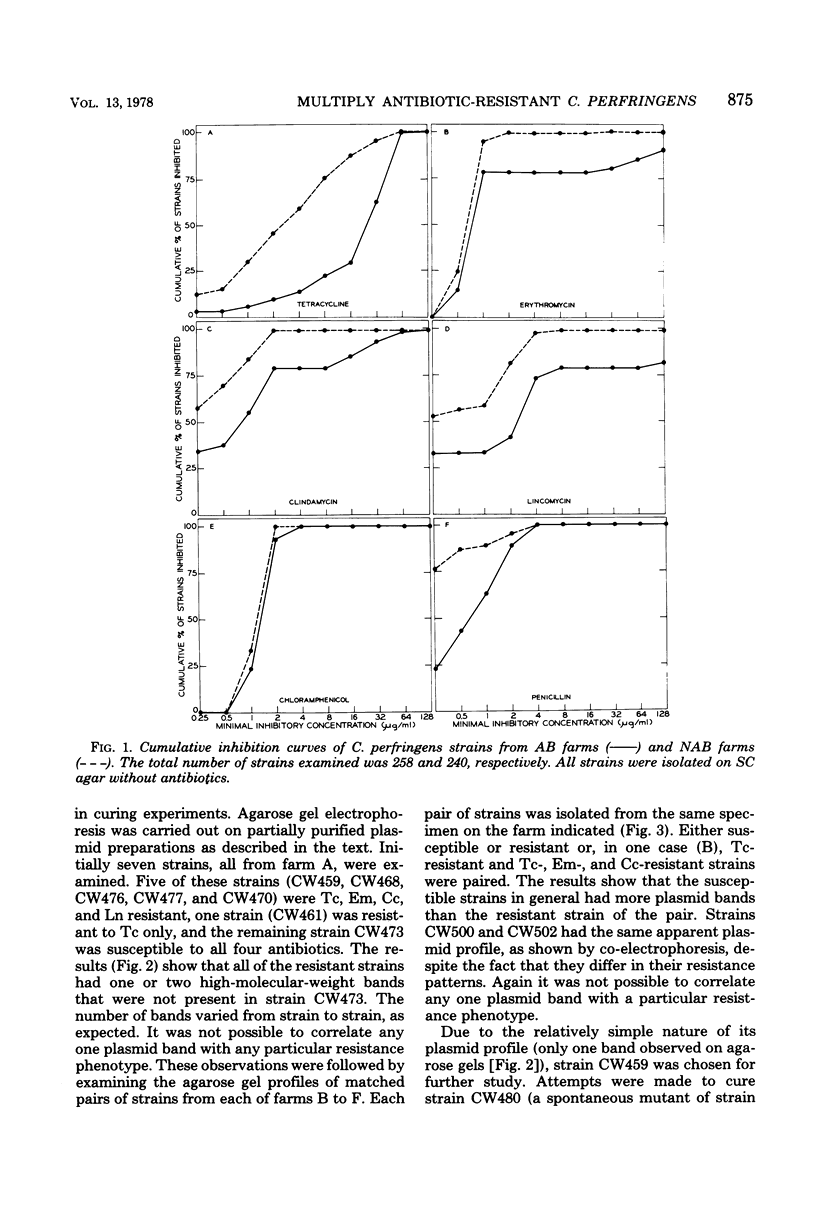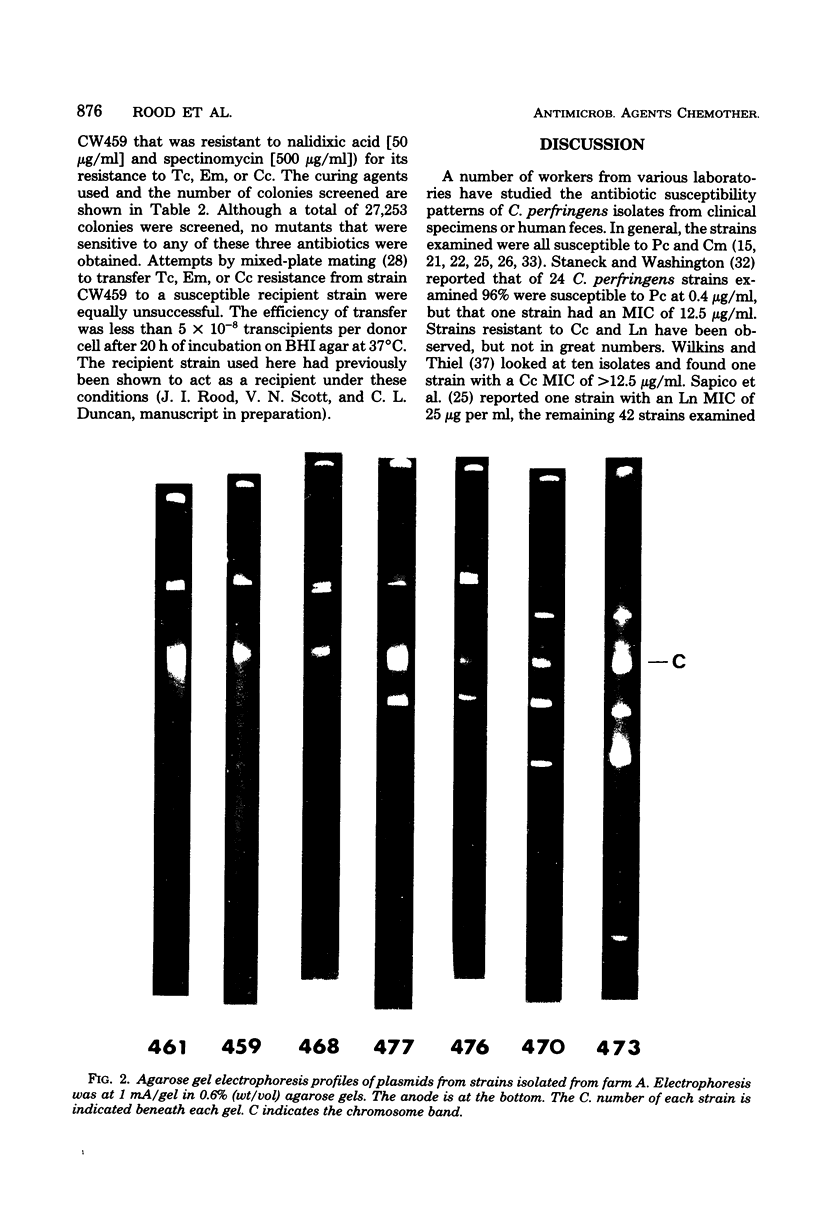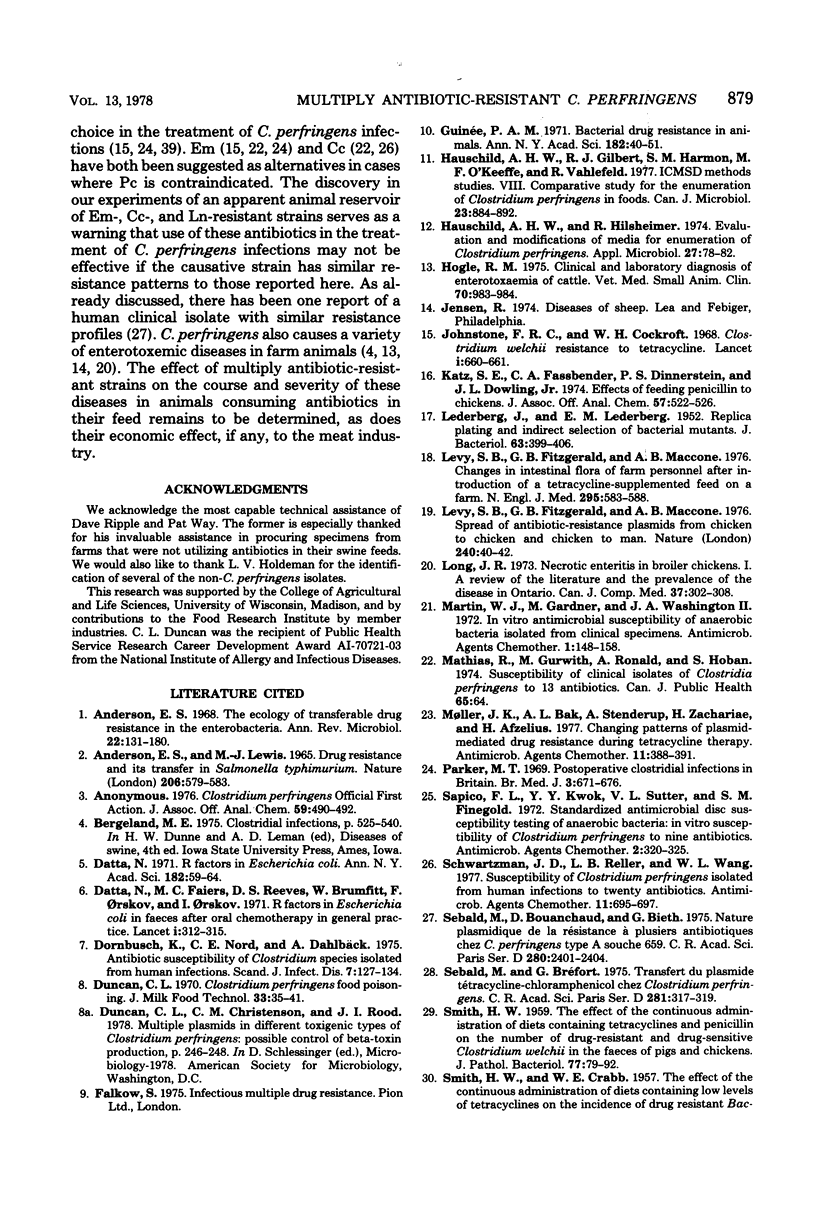Abstract
Multiply antibiotic-resistant strains of Clostridium perfringens were isolated from porcine feces. Strains that were resistant to tetracycline, erythromycin, clindamycin, and lincomycin were isolated, but no penicillin- or chloramphenicol-resistant strains were obtained. Typical minimal inhibitory concentrations for resistant strains were 16 to 64 μg of tetracycline per ml, 64 to >128 μg of erythromycin per ml, ≥128 μg of lincomycin per ml, and 16 to 128 μg of clindamycin per ml. Resistance to erythromycin was always associated with resistance to lincomycin and clindamycin. Minimal inhibitory concentrations were determined for 258 strains from six farms that used antibiotics in their feeds and 240 strains from five farms that did not use antibiotics. The results show that 77.9 and 22.7% of the strains from the former farms were resistant to tetracycline and erythromycin-clindamycin-lincomycin, respectively. The comparable data from the latter farms were 25.0 and 0.8%, respectively. Agarose gel electrophoresis failed to reveal a plasmid band that was common to the resistant strains but absent in the susceptible strains. Attempts to transfer tetracycline, erythromycin, and clindamycin resistance from one strain, CW459, were not successful. Antibiotic-susceptible mutants were not isolated from this strain, despite the use of a variety of curing agents.
Full text
PDF









Images in this article
Selected References
These references are in PubMed. This may not be the complete list of references from this article.
- Anderson E. S., Lewis M. J. Drug resistance and its transfer in Salmonella typhimurium. Nature. 1965 May 8;206(984):579–583. doi: 10.1038/206579a0. [DOI] [PubMed] [Google Scholar]
- Anderson E. S. The ecology of transferable drug resistance in the enterobacteria. Annu Rev Microbiol. 1968;22:131–180. doi: 10.1146/annurev.mi.22.100168.001023. [DOI] [PubMed] [Google Scholar]
- Datta N., Faiers M. C., Reeves D. S., Brumfitt W., Orskov F., Orskov I. R Factors in Escherichia coli in faeces after oral chemotherapy in general practice. Lancet. 1971 Feb 13;1(7694):312–315. doi: 10.1016/s0140-6736(71)91042-7. [DOI] [PubMed] [Google Scholar]
- Datta N. Prevalence of extrachromosomal drug resistance. R Factors in Escherichia coli. Ann N Y Acad Sci. 1971 Jun 11;182:59–64. doi: 10.1111/j.1749-6632.1971.tb30643.x. [DOI] [PubMed] [Google Scholar]
- Dornbusch K., Nord C. E., Dahlbäck A. Antibiotic susceptibility of Clostridium species isolated from human infections. Scand J Infect Dis. 1975;7(2):127–134. doi: 10.3109/inf.1975.7.issue-2.09. [DOI] [PubMed] [Google Scholar]
- Guinée P. A. Prevalence of extrachromosomal drug resistance. Bacterial drug resistance in animals. Ann N Y Acad Sci. 1971 Jun 11;182:40–51. doi: 10.1111/j.1749-6632.1971.tb30641.x. [DOI] [PubMed] [Google Scholar]
- Hauschild A. H., Gilbert R. J., Harmon S. M., O'Keeffe M. F., Vahlefeld R. ICMSF methods studies. VIII. Comparative study for the enumeration of Clostridium perfringens in foods. Can J Microbiol. 1977 Jul;23(7):884–892. doi: 10.1139/m77-130. [DOI] [PubMed] [Google Scholar]
- Hauschild A. H., Hilsheimer R. Evaluation and modifications of media for enumeration of Clostridium perfringens. Appl Microbiol. 1974 Jan;27(1):78–82. doi: 10.1128/am.27.1.78-82.1974. [DOI] [PMC free article] [PubMed] [Google Scholar]
- Hogle R. M. Clinical and laboratory diagnosis of enterotoxemia of cattle. Vet Med Small Anim Clin. 1975 Aug;70(8):983–986. [PubMed] [Google Scholar]
- Johnstone F. R., Cockcroft W. H. Clostridium welchii resistance to tetracycline. Lancet. 1968 Mar 30;1(7544):660–661. doi: 10.1016/s0140-6736(68)92098-9. [DOI] [PubMed] [Google Scholar]
- Katz S. E., Fassbender C. A., Dinnerstein P. S., Dowling J. J., Jr Effects of feeding penicillin to chickens. J Assoc Off Anal Chem. 1974 May;57(3):522–526. [PubMed] [Google Scholar]
- LEDERBERG J., LEDERBERG E. M. Replica plating and indirect selection of bacterial mutants. J Bacteriol. 1952 Mar;63(3):399–406. doi: 10.1128/jb.63.3.399-406.1952. [DOI] [PMC free article] [PubMed] [Google Scholar]
- Levy S. B., FitzGerald G. B., Macone A. B. Changes in intestinal flora of farm personnel after introduction of a tetracycline-supplemented feed on a farm. N Engl J Med. 1976 Sep 9;295(11):583–588. doi: 10.1056/NEJM197609092951103. [DOI] [PubMed] [Google Scholar]
- Levy S. B., FitzGerald G. B., Macone A. B. Spread of antibiotic-resistant plasmids from chicken to chicken and from chicken to man. Nature. 1976 Mar 4;260(5546):40–42. doi: 10.1038/260040a0. [DOI] [PubMed] [Google Scholar]
- Long J. R. Necrotic enteritis in broiler chickens. I. A review of the literature and the prevalence of the disease in Ontario. Can J Comp Med. 1973 Jul;37(3):302–308. [PMC free article] [PubMed] [Google Scholar]
- Martin W. J., Gardner M., Washington J. A., 2nd In vitro antimicrobial susceptibility of anaerobic bacteria isolated from clinical specimens. Antimicrob Agents Chemother. 1972 Feb;1(2):148–158. doi: 10.1128/aac.1.2.148. [DOI] [PMC free article] [PubMed] [Google Scholar]
- Moller J. K., Bak A. L., Stenderup A., Zachariae H., Afzelius H. Changing patterns of plasmid-mediated drug resistance during tetracycline therapy. Antimicrob Agents Chemother. 1977 Mar;11(3):388–391. doi: 10.1128/aac.11.3.388. [DOI] [PMC free article] [PubMed] [Google Scholar]
- Parker M. T. Postoperative clostridial infections in Britain. Br Med J. 1969 Sep 20;3(5672):671–676. doi: 10.1136/bmj.3.5672.671. [DOI] [PMC free article] [PubMed] [Google Scholar]
- SMITH H. W. The effect of the continuous administration of diets containing tetracyclines and penicillin on the number of drug-resistant and drug-sensitive Clostridium welchii in the faeces of pigs and chickens. J Pathol Bacteriol. 1959 Jan;77(1):79–93. [PubMed] [Google Scholar]
- Sapico F. L., Kwok Y. Y., Sutter V. L., Finegold S. M. Standardized antimicrobial disc susceptibility testing of anaerobic bacteria: in vitro susceptibility of Clostridium perfringens to nine antibiotics. Antimicrob Agents Chemother. 1972 Oct;2(4):320–325. doi: 10.1128/aac.2.4.320. [DOI] [PMC free article] [PubMed] [Google Scholar]
- Schwartzman J. D., Reller L. B., Wang W. L. Susceptibility of Clostridium perfringens isolated from human infections to twenty antibiotics. Antimicrob Agents Chemother. 1977 Apr;11(4):695–697. doi: 10.1128/aac.11.4.695. [DOI] [PMC free article] [PubMed] [Google Scholar]
- Sebald M., Bouanchaud D., Bieth G., Prévot A. R. Nature plasmidique de la résistance à plusieurs antibiotiques chez C. perfringens type A, souche 659. C R Acad Sci Hebd Seances Acad Sci D. 1975 May 26;280(20):2401–2404. [PubMed] [Google Scholar]
- Sebald M., Bréfort M. G. Transfert du plasmide Tétracycline-Chloramphénicol chez Clostridium perfringens. C R Acad Sci Hebd Seances Acad Sci D. 1975 Jul 28;281(4):317–319. [PubMed] [Google Scholar]
- Staneck J. L., Washington J. A., 2nd Antimicrobial susceptibilities of anaerobic bacteria: recent clinical isolates. Antimicrob Agents Chemother. 1974 Sep;6(3):311–315. doi: 10.1128/aac.6.3.311. [DOI] [PMC free article] [PubMed] [Google Scholar]
- Sutter V. L., Finegold S. M. Susceptibility of anaerobic bacteria to 23 antimicrobial agents. Antimicrob Agents Chemother. 1976 Oct;10(4):736–752. doi: 10.1128/aac.10.4.736. [DOI] [PMC free article] [PubMed] [Google Scholar]
- WATANABE T. Infective heredity of multiple drug resistance in bacteria. Bacteriol Rev. 1963 Mar;27:87–115. doi: 10.1128/br.27.1.87-115.1963. [DOI] [PMC free article] [PubMed] [Google Scholar]
- Wilkins T. D., Thiel T. Resistance of some species of Clostridium to clindamycin. Antimicrob Agents Chemother. 1973 Jan;3(1):136–137. doi: 10.1128/aac.3.1.136. [DOI] [PMC free article] [PubMed] [Google Scholar]
- Williams K., Brandish J. M., Willis A. T. Some observations on clindamycin. Med Lab Technol. 1972 Jul;29(3):233–242. [PubMed] [Google Scholar]




